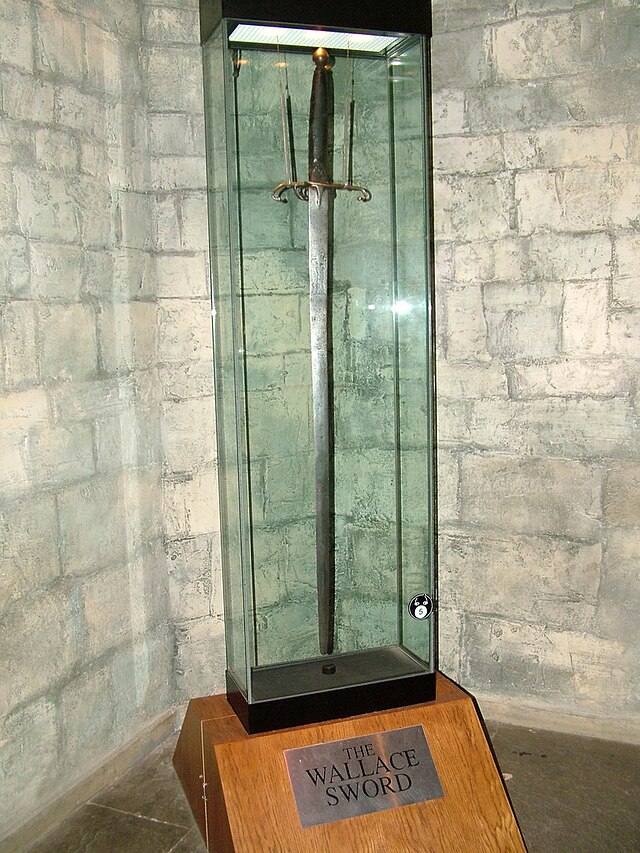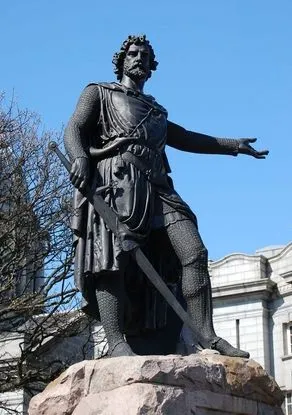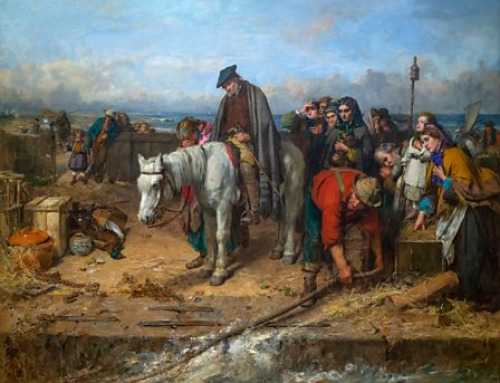The Wallace Sword has pride of place on display in the National Wallace Monument in Stirling it is an antique two-handed sword purported to have belonged to William Wallace the famous Scottish patriot and knight who led a resistance to the English occupation of Scotland during the Wars of Scottish Independence. It is said to have been used by William Wallace at the Battle of Stirling Bridge in 1297 and the Battle of Falkirk (1298). The blade of the sword measures 4 feet 4 inches in length and including the hilt is 5 feet 4 inches, the breadth of the blade varies from 2.25 inches at the guard to 0.75 inches before the point. The sword weighs 5.95 pounds, it’s designed to be used two-handed, but even so, Wallace would have had to be around six feet seven inches to use it. In 13th-century Scotland, the average man was just five feet tall so Wallace must have been of great stature. It has been alleged that after William Wallace’s execution in 1305, John de Menteith, governor of Dumbarton Castle received the sword in August of that year, but there are no records to that effect. Two hundred years later, in 1505, accounts survive which state that at the command of King James IV of Scotland, the sum of 26 shillings was paid to an armourer for the “binding of Wallace’s sword with cords of silk” and providing it with “a new hilt and plummet” and also with a “new scabbard and a new belt”. This repair would have been necessary because, according to legend, Wallace’s original scabbard, hilt and belt were said to have been made from the dried skin of Hugh de Cressingham, who was killed at the Battle of Stirling Bridge. No other written records of the sword are found for a further three centuries. In 1875 a letter from the War Office informed that the sword, in 1825 was sent to the Tower of London to be repaired. At that time it was submitted to Samuel Meyrick by the Duke of Wellington for examination. Dr Meyrick was an authority on ancient swords, but he estimated the age of the sword by examining the mountings only, which were replaced early in the 16th century. Thus he concluded that the sword could not date from earlier than the 15th century. However, he did not take account of the blade, which must have been of some importance for James IV to have it bound in silk and give a new scabbard hilt and belt, and it was also described then as the “Wallas sword”.

Wallace’s sword has been of great symbolical importance to people down the centuries, and every Scot should look at it, study it and think of what it means in the history of Scotland. In the nineteenth century, the people fighting for the reform of the political system used a drawing of the Wallace Sword at the top of their daily newspaper, “The Liberator”. They saw themselves as fighting for political freedom in the same way Wallace had fought for freedom from English oppression. Wallace was taken to Dumbarton Castle after his capture, before being sent to London to be killed. His sword was left at Dumbarton for centuries. When the Stirling people asked for it to be sent to the Wallace Monument, the army refused, because they said the sword was not real. When the sword was finally sent to Stirling, the people of Dumbarton protested against this
The sword was recovered from Dumbarton by Charles Rogers, author of The Book of Wallace. Rogers, on 15 October 1888, renewed correspondence with the Secretary of State for War, with the result that the Major General commanding forces in North Britain were authorised to deliver the weapon to his care for preservation in the Wallace Monument. More recently, it was taken to New York as the centrepiece of the 2005 Tartan Day celebrations. This sword was seen at Dumbarton Castle by the famous poet William Wordsworth and his sister Dorothy when they toured Scotland in 1803. One of the soldiers in the garrison told them it was Wallace’s. This is the first time the sword is known to have been associated with the Scottish hero – was the soldier deliberately telling a tale for these English visitors? Maybe it doesn’t matter if the sword isn’t the one used in battle by Wallace. It’s now the main focus of the cult that has developed around his memory. In the popular imagination, it’s highly appropriate – large, plain and business-like for a man of action, a man of the people.




Leave A Comment